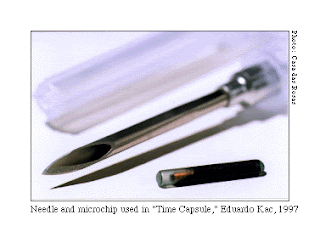In this week’s topic, I learned that medicine, particularly anatomy and dissection, is truly the intersection of art and science. The work I found most interesting was Eduardo Kac’s “Time Capsule” project. On November 11, 1997, an artist by the name of Eduardo Kac implanted a microchip in his own ankle. With the microchip embedded into his body, he became the first human to be added into a remote database typically used for lost animals. The artist set up the “art gallery” to look like a medical room, with equipment that could be found in typical hospital rooms. It’s interesting to see that many artists and doctors would actually operate on themselves, being both the innovator and patient at the same time.
 |
| Eduardo Kac's Time Capsule Gallery |
 |
| Warwick with RFID Chip |
I also found Diane Gromala’s Ted Talk, “Curative Powers of Wet, Raw Beauty” intriguing. She noted that statistically one in every five people have chronic pain, and that virtual reality is an effective alternative to relieve short-term pain because the user is so intensely distracted by the immersive media. Although I have not experienced virtual reality before, I believe Diane’s research is true. In Duke Dumont’s “I Got U” music video, a man used a virtual reality headset to escape from his sad, rainy environment to a paradise island. However, his excitement and happiness was only short-lived as he had to go back to reality when the song ended.
Works Cited
DukeDumontVEVO. "Duke Dumont - I Got U (Official Video) Ft. Jax Jones." YouTube. YouTube, 19 Feb. 2014. Web. 24 Apr. 2016.
Kac, Eduardo. "Time Capsule." Time Capsule. N.p., n.d. Web. 24 Apr. 2016.
TEDxTalks. "TEDxAmericanRiviera - Diane Gromala - Curative Powers of Wet, Raw Beauty." YouTube. YouTube, 07 Dec. 2011. Web. 24 Apr. 2016.
Uconlineprogram. "Medicine Pt3." YouTube. YouTube, 22 Apr. 2012. Web. 24 Apr. 2016.
Warwick, Kevin. Kevin Warwick, n.d. Web. 24 Apr. 2016.











